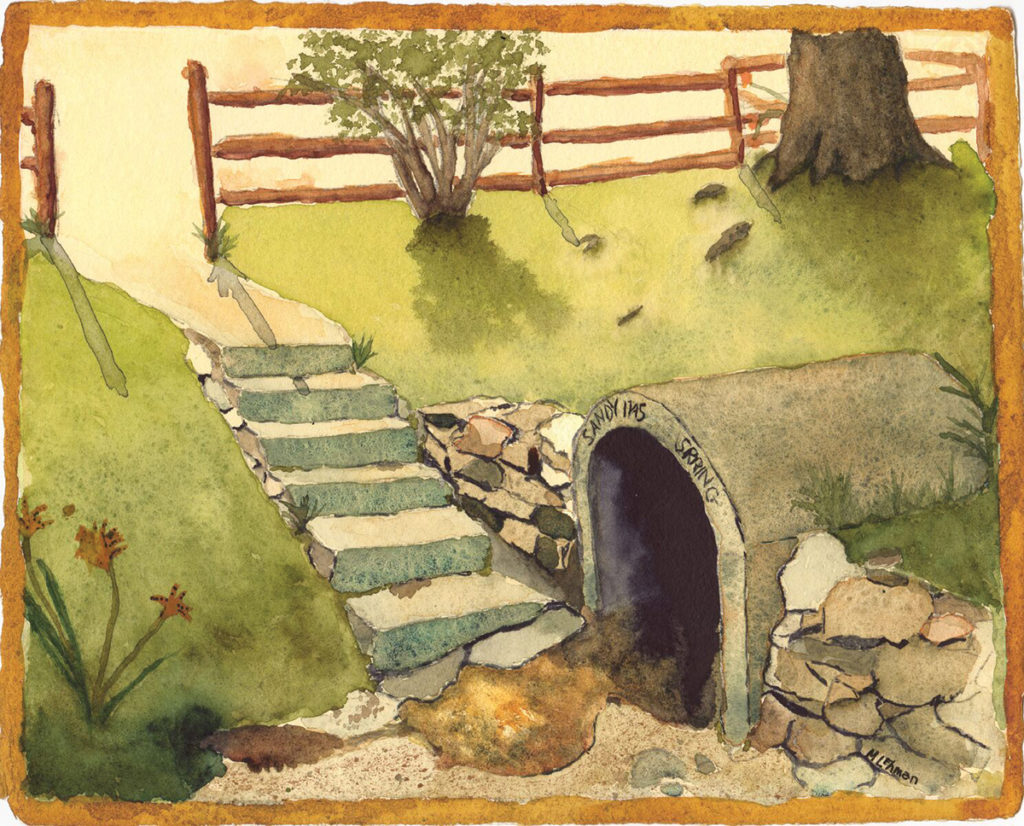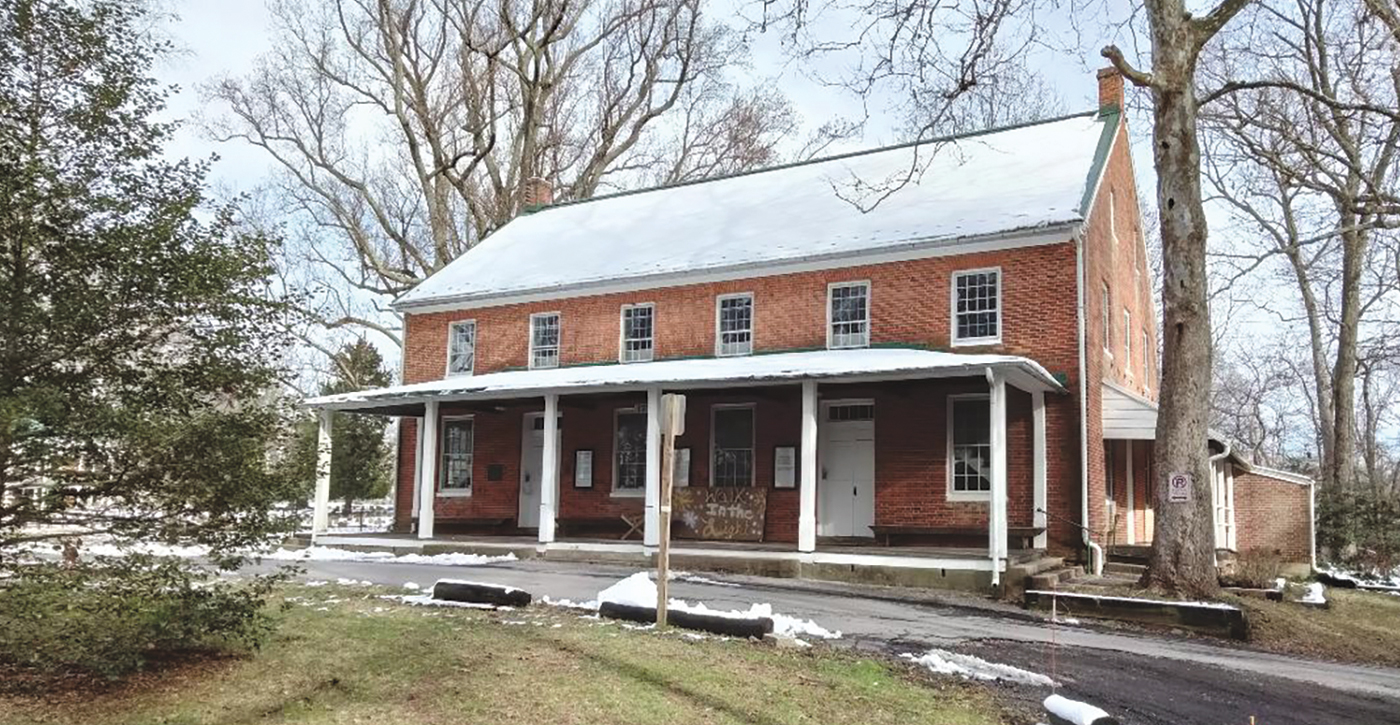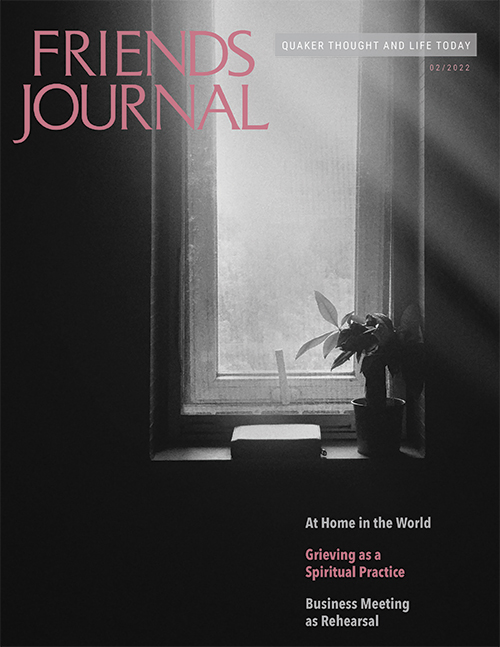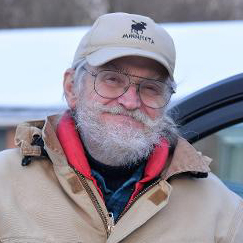When Friends first arrived in the Sandy Spring, Maryland area in the 1730s, it is traditionally told that they gathered in an old tobacco barn, cleaned up for the purpose. Our record of being “Sandy Spring Monthly Meeting” dates to 1753. Our present meetinghouse, when completed in 1817, was the largest house of worship in the county and held that distinction for many years. Leading to the meeting from a well-traveled state highway on the north side, Meeting House Road is less than a mile long and has been declared a “rustic road” by our county. On the south side, Meeting House Road continues and becomes essentially a driveway for our neighbors; leads to the Sandy Spring, the fresh-water spring that names our community; and connects us to the end of the Underground Railroad Experience Trail, a hiking trail established by the county parks department as part of a National Park Service program. Thus arranged, we get many “tourists.”
The land around Sandy Spring Meetinghouse, with our wooded acreage, old historic graveyard, and convenient parking lot, has become, in essence, “Sandy Spring Central Park”: hikers, dog walkers, neighbors, and folks seeking history and scenic peace often come to visit. “I didn’t know this was back here,” many of them say. “What is this place?”
I have a reputation in our meeting for taking pleasure in talking about Quaker history and faith, especially as it pertains to the Sandy Spring area, which was founded by Quakers. I am still surprised at the number of people visiting who are fairly ignorant of our existence. “Quakers? I thought you were all dead!”

The Source II, watercolor painting of the Sandy Spring by Margo Lehman.
On Saturdays and Sundays, I work part time at Friends House Retirement Community, just “around the corner” from Sandy Spring Meeting, driving the bus and doing other errands. Thus I often must miss First-day meeting for worship. Beginning around 1:00 p.m., I like to take my lunch break at the meeting. Sometimes I water plants. Sometimes I burn weeds. Often I greet visitors.
One typical Saturday last summer, I came to meeting to take my break. Throughout that afternoon, as I busied myself (Ah! Weeds to burn . . .), we had some visiting “tourists,” each with a different story.
The first was a couple new to the United States who had hiked the two miles up from Woodlawn Manor, the beginning of the Underground Railroad Experience Trail. (Built in the early 1800s by a Quaker family, the Woodlawn Manor House is now part of a cultural and historic park that also includes an 1832 stone barn, which operates today as a museum.) The couple had walked the trail seeking to find and learn more about this “Underground Railroad.” Their sincere, honest desire to find “tracks, tunnels, and trains” was apparent. I am almost sorry to disabuse folks whom I meet of this misapprehension, but it does happen. “I am sorry but there are no underground tunnels here. And no locomotives or iron tracks,” I tell them.
Their confused looks prompted further explanation. I smiled, and continued: Back in the 1830s, the railroad was the latest thing, the fastest thing. So the clandestine means to freedom for the enslaved became known as a “railroad,” with “stations” and “conductors” and “freight” or “passengers.” Yes, Quakers were among those who aided in this network. “Underground” referred to the secrecy involved in such work. No tunnels, except perhaps the one from the manor house basement out to the spring house. Since there is no real evidence any freedom seeker actually used this trail—it could’ve happened, but there’s no documentation so no way to know—the Underground Railroad Experience Trail is therefore called an “experience.”
After our discussion (no, the Sandy Spring Meetinghouse was not a “station” on the Underground Railroad), I was able to invite them into our Lyceum/Community House to view our art gallery featuring local artists.
The second pair, two friends, also hiked up from Woodlawn, and I was able to open the meetinghouse to show them our place of worship. They were Jewish and had some good questions for me (“No rabbi? No clergy?”) about how and why Quakers do what we do. Then one of them asked something that made me think: “How much do you have to pay to join your meeting?” “Have to pay?” I asked. “Yes,” she said and offered up that her synagogue requires “a large sum” paid annually in order to be a member. I explained that we do not require any money; folks contribute whatever the Spirit leads them to contribute. Her reply: “. . . and that works? Your bills get paid?” I said, “Yes, it seems to work.” “So how do people join your meeting then?” I said anyone is welcome to worship with us, at any time. We don’t ask for an admission or membership fee, but we do remind folks of the needs. Membership, as such, is another thing entirely. People might worship with us for many years without actually asking for membership. She nodded, but I’m not sure I had convinced her. They also came in to view our art gallery.
Next, a solo hiker walked up. “Excuse me, what is this place? Is that the ‘Champion White Ash Tree’ (listed as a feature on the UGRR experience trail map on her phone)?” She pointed at the really impressive tree in the middle of our graveyard. She too had walked up from Woodlawn, but as is often the case, did not take a paper map (much more detailed) from the info kiosk (were they out?) at the trailhead. “No,” I replied, “that is our used-to-be State Champion tulip poplar; they tell us now it measures in the top ten biggest. . . . No, this is not a part of the ‘official’ Underground Railroad Experience Trail. Here is a map. . . . Would you like to see the meetinghouse?” She later took one of the graveyard brochures (a self-guided tour) and proceeded to walk around, examining the plain headstones.
The fourth pair (it was a busy afternoon!) drove in. They explained some relatives of theirs attended Quaker meeting in Pennsylvania, and they had driven by Meeting House Road many times and finally decided to turn in. They were not Friends (attend Methodist church), but having Quakers in the family and some Quaker “experience,” came in to visit. Our history and site seemed to impress them. “No clergy? No church staff? How do you learn and keep track of things?” I explained our desire to invite God’s Spirit to instruct us as it will, and that everyone here—yes, everyone—is a volunteer. Yes, we pay some professionals to get things done, but they get done because one of us sees the need and “sees to it.” Patch a roof? First-day school for the kids? Weeds in the walk? Clean the kitchen? Bible study? Yep, but someone is moved to take that “care” under their leadership. “We have committees,” I finally admit. Heads nod. They also viewed the art gallery before continuing on their way.
And I went back to burning weeds.





Thank you, I felt was visiting a little myself.
I also appreciate all the information given to “outsiders” in such a charming way!
I hope you can continue your inspired work for a long time to come.
Several years ago my wife Darlene and I drove from western Virginia to attend the Bible conference being held on the Sandy Springs Friends “campus.” As we drove in, the lot was full of cars. I said to Darlene: “there must be something else going on here today.” But no; it was the Bible conference. We attended and enjoyed it, always wanting to come back the next year. Unfortunately, some Baltimore Yearly Meeing folks were unhappy about the event’s popularity, and prevented it from happening in the same format again.
Bill Rushby
A delightful reflection.
I would love to think the weeds can be composted rather than burnt. (Composting is one of the great metaphors for spiritual experience.)
Thank you for the thought. I have not considered “composting” in a spiritual context. Unfortunately, that would mena pulling each leeetle weed up separately. Hard to do efficiently !
As a person of Jewish descent, the part about the two Jewish people resonated with me. While my family of origin was not very observant, I was involved in a Jewish youth group with my friends. You could attend the synagogue, and the youth group, without being members. But if you wanted good seats for the High Holiday services (Rosh Hashanah–the new year–and Yom Kippur–the Day of Atonement) you had to join. Becoming involved with Quakers was odd, since it is rooted in the Christian tradition. Less odd in a progressive Quaker Meeting because most attenders did not refer to Jesus, generally preferring the terminology of the Divine or the the Light. But when I learned there was no membership fee I was rather perplexed about why someone would become a member. What are the perks? Being able to serve on membership clearness committees hardly seemed compelling. It never occurred to me that I would join because I wanted to be publicly affiliated with a faith group whose practices moved me.
Thank you James Lehman for sharing these encounters. I’m glad that others now are learning that Jewish congregations let you join if you pay. (Of course, that’s not the only criteria to join!) Occasionally I bring this fact to the attention of my meeting when we discuss Stewardship and Membership, etc.
Friends, are you the meeting that was responsible for the Old Friends Burial Ground in Baltimore? I understand it has become a national heritage site. I have lost the name of the meeting that took care of it. My family: parents, grandparents, etc., are buried there. I believe my father may be the last one buried there. Thank you!
No, Sandy Spring Meeting has no charge of that graveyard. You might inquire of Baltimore Yearly Meeting. They have made a study of all the graveyards in the BYM area. https://www.bym-rsf.org/ Perhaps Stoney Run Meeting or Homewood Meeting.
Good travels to you, Friend.